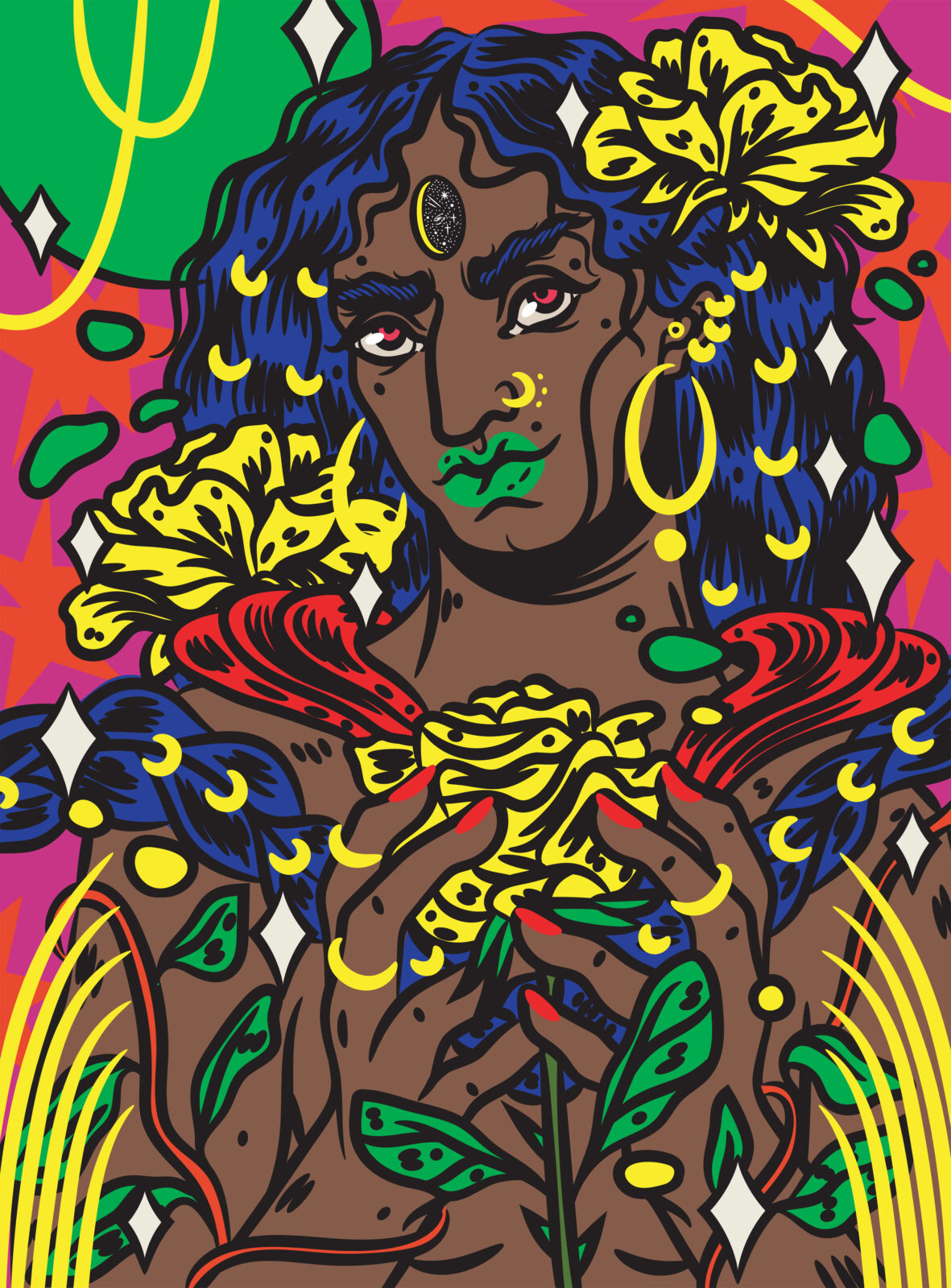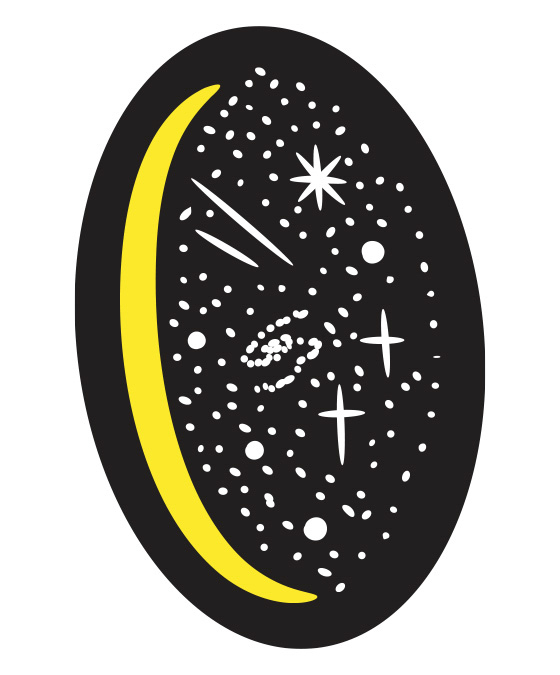
Illustration by Osheen Siva from the Healing Practices issue of Spiral magazine

Illustration by Osheen Siva from the Healing Practices issue of Spiral magazine
The heat was stifling. As the steam rose from water being poured over the fire-heated stones in the center of the sweat lodge, Maria Farfan laid down for a reprieve from the heat. It was the Colombian native’s first time participating in an indigenous ceremony in the highlands of her homeland, and the first time she consumed ayahuasca, a psychoactive tea derived from several plants endemic to the Amazon rainforest.
As her body melded with the earthen floor, she was suddenly overwhelmed with sadness as she remembered how she’d polluted or wasted precious natural resources throughout her life. “I recognized all the damage that I had done to the earth,” she said. But in that moment of realization she also had a vision. She became a part of the earth. The flowers began speaking to her. The mountains were breathing with her. And as Mother Earth forgave her, a pink rose bloomed from the center of her heart. “I felt that my apologies were well received by Mother Earth.”
Remembering the sacredness of these medicines is vital, says Buch. When that spiritual intent is removed, she said, “It’s just a drug.”
Since that first psychedelic journey more than ten years ago, Farfan has dedicated her life to learning how indigenous peoples use sacred entheogenic plant medicines in North and South America and how to facilitate these types of experiences for others looking to heal or expand their consciousness and deepen their spiritual practice.
Farfan is part of a burgeoning global psychedelic movement, commonly referred to as the psychedelic renaissance, that is infiltrating mainstream culture. After decades of criminalization, states across the United States are now decriminalizing or legalizing the use of magic mushrooms and ayahuasca. Major research institutions, including Johns Hopkins Medicine and the University of California, San Francisco, are conducting clinical trials researching the potential for psychedelics like MDMA and psilocybin to treat people suffering from post-traumatic stress disorder, depression, addiction, and other mental illnesses, with promising results. And financial investors are ready to pounce on what is expected to develop into a profitable new psychedelic pharmaceutical industry.
But looming over the excitement around psychedelics and their potential to heal are overarching concerns shared by Farfan and other female doctors, historians, and psychedelic advocates, who have been largely underrepresented thus far in what they describe as a male-dominated field. As psychedelic medicine is increasingly commercialized, they worry about the potential for harm if used without the proper guidance and oversight.
“We have to be very careful in delineating how it’s used,” says Sara Garcia Velasquez, a physician from Mexico and associate medical director at MAPS Public Benefit Corporation, which promotes the research and development of psychedelic pharmaceuticals.
In recent years, multiple deaths have been reported among people who have participated in ayahuasca retreats in South America. Sexual assault of women in these types of psychedelic plant medicine ceremonies and in clinical psychedelic-assisted therapy sessions settings is an ongoing issue. And for people with a predisposition for psychotic disorders, using psychedelics can increase the risk of psychosis. This is why it’s critical to conduct a diligent screening process before selecting people to participate in the many current psychedelic drug trials being conducted globally, says Katrin Preller, a neuroscientist researching the efficacy of psilocybin as a treatment for alcoholism at the Psychiatric University Hospital Zurich in Switzerland.

Putting a price on psychedelic medicine may also prevent some populations who could really benefit from their use from having access to them, exacerbating existing inequities in healthcare for the uninsured and other marginalized communities, says Velasquez. Already, the popularization of sacred plant medicine is jeopardizing access to these medicines for the very people who have traditionally used them for centuries, says Farfan. In Mexico, for example, the peyote cactus is endangered due to overharvesting for commercial purposes.
How to address these myriad challenges in the growing field of psychedelics is part of an ongoing discussion with few clear answers as of yet, says Velasquez, who has been overseeing MDMA-assisted therapy trials for people with PTSD. However, learning how ancient cultures have integrated plant medicine into their daily lives for thousands of years may provide some guidance.
“If we put psychedelic science back into its cultural context, it actually explodes with opportunities,” says Erika Dyck, psychedelic historian and professor at the University of Saskatchewan in Canada.
For millennia, indigenous peoples all over the world have used entheogenic plant medicines such as peyote, San Pedro, iboga, ayahuasca, and sacred mushrooms for healing, achieving expanded states of consciousness, and communing with nature and the divine. Some of the most ancient Hindu texts, known as the Vedas, reference Soma, a plant-based elixir believed to have had psychedelic properties that was consumed and offered to the gods during religious ceremonies, says Kamya Buch, a psychedelic educator based in South India and founder of the Entheogenic Society India, an online and in-person network dedicated to fostering awareness around the traditional use of psychedelics worldwide.
Remembering the sacredness of these medicines is vital, says Buch. When that spiritual intent is removed, she said, “It’s just a drug.”
Traditionally, these medicines were rarely used in isolation from other spiritual practices. They were combined with other disciplines including meditation and pranayama, or breathwork, says Buch.
Even currently, when indigenous peoples from South America partake in ayahuasca ceremonies, for example, they are encouraged to abstain from certain foods or behaviors before and after they ingest the medicine so as to prepare the body and maximize its potential for healing, says Farfan. In Native North American peyote ceremonies, she says, the medicine is just one part of a very structured and communal ceremony that involves singing, feasting, and calling upon the natural elements for guidance. “The ritual itself is a healing practice.”
These processes are just as important as taking the actual medicine, says Farfan, who is enrolled in a one-year psychedelic assisted therapy program at the Integrative Psychiatry Institute in an effort to bridge ancestral healing traditions with contemporary psychedelic medicine. They prepare the body and mind for what can be a physically and emotionally taxing experience, albeit powerful. The ritual and ceremony are means for remaining grounded during expanded states so participants can more easily integrate the spiritual experiences they may have. The ceremonial context also helps sustain the long-term healing effects of these medicines, she says.
Drawing from these indigenous practices, the psychiatric community involved in conducting clinical trials with psychedelics has already begun to create more ritualistic structured parameters for participants. For example, in the MDMA-assisted therapy sessions Velasquez oversees, participants are required to engage in several therapy sessions before and after being administered MDMA. In the session where they consume the medicine, they are accompanied by a facilitator the entire time. They may also listen to specific music to potentiate the session. All of these things help create what is commonly referred to as a safe “set and setting” in order to minimize harm and create an optimal experience for those taking psychedelics.
And it’s working. Study results, thus far, have shown a significant percentage of people with PTSD showed improvement after participating in MDMA-assisted therapy sessions. “They were no longer subjected to this repetition of pain and trauma they’d been subjected to for so many years,” says Velasquez. Much credit is due to the indigenous peoples who helped pave the way for this breakthrough science, she said.
“We wouldn’t have gotten to where we are without incorporating ancestral traditions of ritual.”

Teresa Tomassoni is a journalist reporting on social and environmental issues, particularly as they pertain to Indigenous peoples. She has lived, studied, and reported in Latin America, Asia, and Australia, and holds degrees in journalism from the CUNY Graduate School of Journalism and international health and social work from LIU Global, a program of Long Island University.
Get the latest news and stories from the Rubin, plus occasional information on how to support our work.